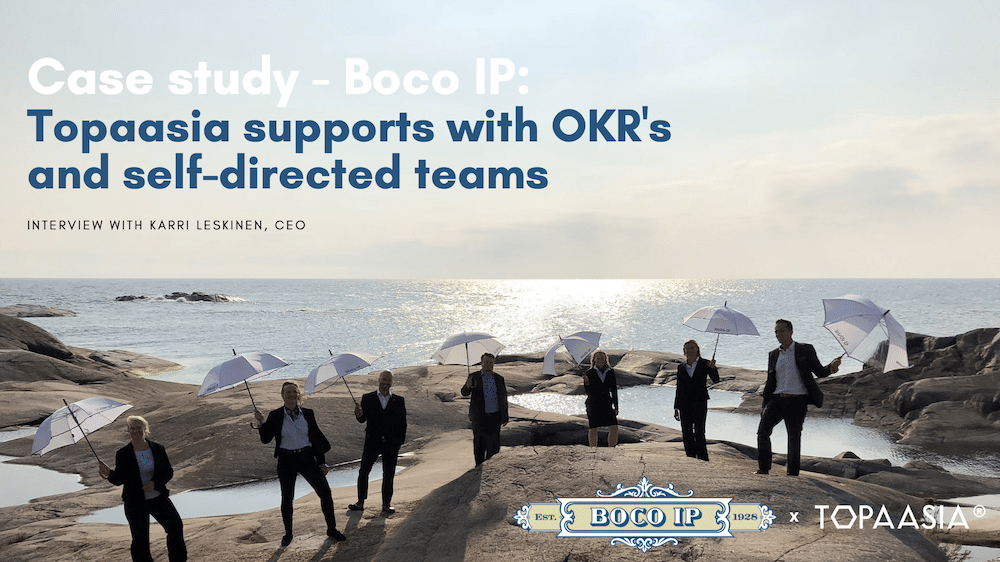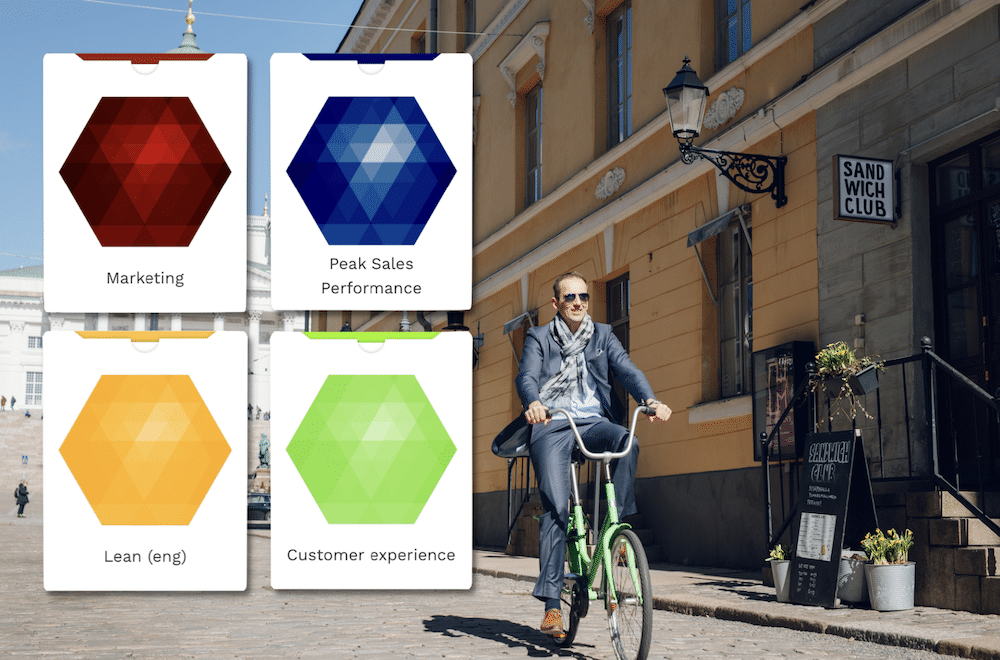Case study – Boco IP: Topaasia in support of OKRs and self-organizing teams

Boco IP is a patent office specializing in the management of intangible assets, with long roots in the early part of the century, first as a family business and then as a company owned by key personnel. In an interview, Boco IP’s CEO Karri Leskinen explains how the company takes advantage of self-direction, OKR’s and Topaasia games when taking the company towards the future.
Karri Leskinen has been the CEO of Boco IP since 2007, with a clear goal from the beginning: “I wanted a place where I could enjoy myself. I was sure I would enjoy the workplace if my colleagues were doing well. I really focused on creating the best workplace in Finland, ”says Leskinen about his goal as CEO.
Topaasia games have been involved in building this goal, which the company has utilized to support the activities of self-directed teams.
The spectrum of different leadership cultures challenged to change thinking
As CEO, Leskinen has piloted the company through several different management cultures. From the loose management culture of the early years, a leader- and management team-driven organization was developed, which a few years ago returned experimentally to the early self-directed organization: first by dismantling the roles of supervisors, later by giving up the management team. Now the organization is built around self-directed teams, and taking care of the needs of employees is the responsibility of different service counters. Leskinen opens up the operating model through examples: “If a team needs sales and marketing support – such as support in building a campaign – they don’t seek it from the management team or supervisor, but go to the sales and marketing service counter. If they need recruitment assistance, they go to the HR service desk. As CEO, I am discussing things with the service counter, and we can always focus on one aspect at a time. ”
The operating model ensures that only the necessary people are in charge of each matter, and that the time of others is not spent dealing with things. Decision-making is implemented where there is information to make decisions, and teams are responsible for making decisions and making their own decisions. “When responsibility is shared, people like to take it and find it motivating and meaningful, and there is no such culture of asking for permission,” Leskinen describes.
The most important change Leskinen states, is the removal of the culture of applying for a permit, which is reflected not only in everyday practice but also in the level of employees’ thinking: employees have to consider their own actions not only from a personal perspective but also from a team and company perspective. Adopting an operating model has challenged employees to adopt new skills. “Yes, there’s a lot to learn when it comes to making decisions from your own perspective, and you should consider why this is a good decision from a business perspective.” Leskinen describes, and also continues, his own role in supporting the employee learning process: “First, you make sure they have the knowledge they need to make decisions, but also the ability to ask themselves the right questions.”

Karri Leskinen
Trials & errors of self-direction
Leskinen describes the future, development and various experiments as key factors in the corporate culture. This has also been reflected in various experiments in the implementation of self-direction. Initially, the aim was to develop the teams using the traditional looping method, which seeks to find the shortcomings of the operation and to invent more efficient operating models for them.
It was quickly realized that this left only the nudging of existing processes, which was not enough to achieve the desired goals. This included an examination of the bigger picture of the future and the OKR (Objective and Key Results), through which the perspective was extended from the examination of the actions taken to future objectives, or as Leskinen summarizes: “It is an activity and a future, it is not a mirror. ”
Topaasia – gaming to help set OKRs
Topaasia games are used with Boco IP to set OKRs. Through Topaasia – games, teams strive to identify key factors for team operations that develop the team’s internal operations while bringing it closer to the perspective of the future created from the perspective of the entire company. The games are played at regular intervals, and the game decks are selected according to what Boco IP’s destination statement document has decided to focus on.
Repeated playing on Boco IP has made it possible to notice your own progress, and the use of different decks has also challenged Teams to identify the progress still required. “For example, with the sales and marketing team, we first thought we no longer had anything new to come up with. When we first tried the new decks, top sales performance– and marketing decks, eyes opened. Ah, we still have so much to do, ”Leskinen describes the insight.
At Boco IP, Leskinen has been responsible for facilitating the games in all teams. This has strengthened the interaction with otherwise independent teams, as well as made it possible to review the OKRs of the teams in relation to the development guidelines of the entire company. Playing Topaasia has been perceived as an effective way to develop activities, and time has been prioritized for gaming in the middle of everyday life. The company has already developed a routine for playing through repeated game sessions, which Leskinen concretely opens: “Our basic set is three decks with two perspectives, ie six rounds in an hour and a half, half an hour per deck, but at best we have gone for it in an hour. That’s super efficient. And yet people feel that they got a good discussion about it and that it made sense and found things to promote. ”

Boco IP has been used specifically for Customer Experience, Marketing, Lean and Top Sales Performance – games to support OKR discussions
Games help with setting goals according to big picture
According to different themes, Boco IP has used several different decks, but regardless of the topic, Leskinen describes the game as supporting the creation of OKRs: “It facilitates the discussion and crystallizes what is now most important to the team from some point of view.” Through the measures set in the games, Leskinen describes how the company has also reached the challenges of the ultimate team organizations: the team cannot choose OKR as a matter where success depends on factors other than the team’s own doing. “A team can only succeed by doing it on its own,” he sums up this perspective.
Leskinen cites the example of customer satisfaction and experience: “Our vision is to provide the best customer experience. How do we start digging this? What should we do? The challenge has been that we don’t get to know exactly what the new doing would be. ” Leskinen describes the support that these games have brought to these situations: “Let’s take Topaasia Customer Experience deck, play it through and see what things rise up from that: what are our weaknessess, strengths and most important thing to develop. The deck contains pre-thought actions and things. It’s been great. ”

Boco IP uses service desks that help self-directed teams. CEO helps and develops various areas with service desks.
Identifying bottlenecks toward the goals of the bigger picture
Topaasia games have challenged teams to let go of ingrained mindsets. For a long time, employees have been familiar with identifying operational shortcomings and coming up with solutions to eliminate them, which in itself takes the team forward, but the big picture is now seeking a more permanent change in perspective from the past to the future. “The grievances are easy, but I wish we could get more into what’s most important right now,” Leskinen describes, and continues to reflect on the change in perspective: would be most conducive to their development right now. After all, they know it themselves or I wish they knew.
The games have also required teams to have the courage to choose OKRs. Leskinen describes how, at the end of the game sessions, there may have been a choice between two development-topics, one of which is easier to come up with, but the other may be more central in content. In these situations, Boco IP has a good understanding of the nature of the game as a tool to serve the teams – and this tool is tailored to the needs of the team in a changing situation. ”After the game session, the team holds a separate meeting that may take both topics for further discussion, so you don’t even have to make that choice at that point in the game, ”Leskinen describes the modified ways of working.
“The game puts someone else’s contemplation into a structural facilitation. Someone has thought through those questions. Self-direction, especially when you are a new self-directed organization where you do not have experience in self-management, requires external leadership and facilitation for your own decision-making. After all, tools like this are the most powerful to help with that. You will be given ready paths to make reflections and decisions, ” Leskinen concludes.
Thanks Boco IP and Karri!
Karri Leskinen – LinkedIn
Boco IP
